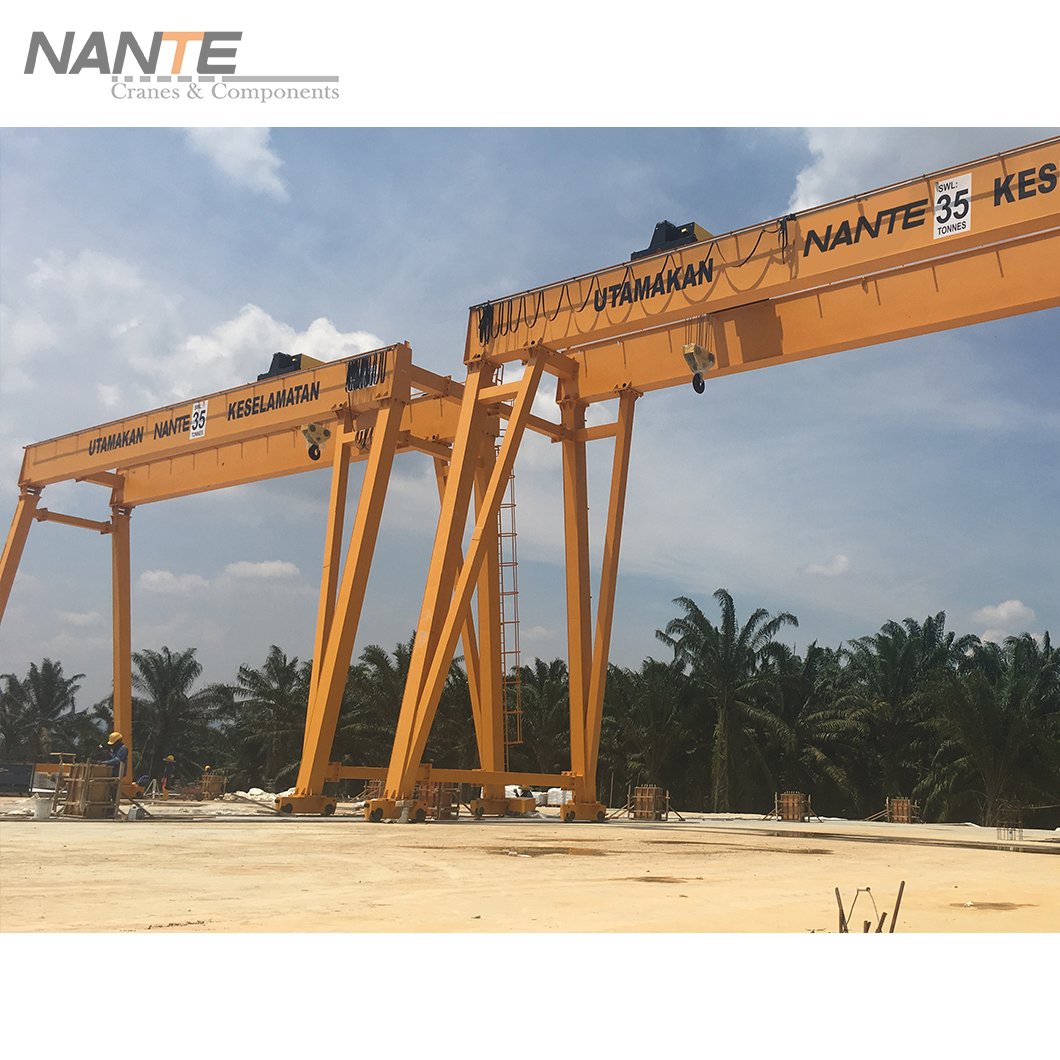Unlock Efficiency Discover the Benefits of Gantry Cranes in Industry
Date: 2024-07-25 Share:
In today’s dynamic industrial landscape, achieving operational efficiency is paramount. One significant contributor to this efficiency is the use of gantry cranes. This article explores the multifaceted benefits of gantry cranes in industrial settings, shedding light on their indispensable role in enhancing productivity and safety.
Understanding Gantry Cranes
Definition and Functionality
Gantry cranes are robust lifting devices used to move heavy loads across industries. Characterized by their overhead beams supported by legs that can move on rails or a fixed path, gantry cranes play a pivotal role in material handling. They are designed to handle bulky and cumbersome loads efficiently, streamlining operations and boosting productivity.
Types of Gantry Cranes
Single Girder Gantry Cranes
Single girder gantry cranes feature one main horizontal beam or girder. These cranes are often used for lighter loads and smaller operations. Single girder designs offer a cost-effective solution for industries where space and budget are concerns, making them an excellent choice for warehouses and small manufacturing units.
Double Girder Gantry Cranes
Double girder gantry cranes incorporate two horizontal girders, enhancing their load-bearing capacity and stability. These cranes are ideal for heavy-duty applications and environments that demand the lifting of extremely heavy loads. They provide added flexibility in terms of the height and width of the lifting area, making them suitable for large-scale industrial operations.
Portable Gantry Cranes
Portable gantry cranes offer the flexibility to move the crane to different locations as needed. These cranes are typically used in workshops or industries where there’s a need for flexibility in lifting operations. Despite their mobility, portable gantry cranes are engineered to be remarkably sturdy and reliable, ensuring efficient material handling across various tasks.
Components of a Gantry Crane
Gantry cranes consist of several key components: the main girder(s), legs, trolley, hoist, and rails or wheels for movement. The hoist is responsible for the lifting and lowering of loads, while the trolley moves horizontally along the girder. Each component works in concert to ensure the smooth and efficient operation of the crane, reducing downtime and enhancing productivity.
As one of the famous brands in the production of winches, cranes and crane parts, Nante Crane is dedicated to research and development of lifting and material handling technologies. We adopt innovative ideas and design in developing new products and services. Backed up by a wealth of industrial experience, we can provide customers with high quality lifting equipment and components.
Enhanced Operational Efficiency
Increased Load Capacity
Gantry cranes are designed to handle substantial weights, often outperforming other types of lifting equipment. The ability to lift and move heavy loads effortlessly directly translates to increased operational efficiency. Industries that deal with substantial weight—such as shipbuilding, steel mills, and manufacturing—find gantry cranes invaluable for their load-bearing capabilities.
Flexibility and Versatility
One of the standout features of gantry cranes is their flexibility. Whether in terms of mobile or stationary configurations, these cranes can be tailored to meet specific industrial needs. They can span vast distances, handle various load sizes, and operate in diverse environmental conditions. This versatility makes gantry cranes an essential asset in industries ranging from construction to aerospace.
Cost-Effectiveness in Material Handling
Investing in gantry cranes can lead to significant cost savings over time. By streamlining material handling processes, reducing manual labor, and minimizing the risk of damage to goods, gantry cranes can lower operational costs. Their durability and efficiency also translate to fewer repairs and replacement needs, further enhancing their cost-effectiveness for industrial applications.
Improved Safety Standards
Reduced Manual Labor Risks
Gantry cranes significantly diminish the need for manual labor, thereby reducing the risks associated with physical strain and injury. Manual handling of heavy loads often leads to musculoskeletal injuries among workers. With the deployment of gantry cranes, these risks are minimized, creating a safer working environment. This reduction in manual labor also lowers insurance and liability costs for companies, further proving their utility.
Advanced Safety Features
Modern gantry cranes are equipped with various advanced safety features that ensure safer operations. These features play crucial roles in preventing accidents and ensuring that operations are carried out smoothly and securely.
Overload Protection Systems
One of the vital safety mechanisms in gantry cranes is the overload protection system. This system prevents the crane from lifting loads that exceed its maximum capacity, thus averting potential mechanical failures and accidents. It includes sensors that detect overload conditions and automatically halt operations, safeguarding both the equipment and the operators.
Anti-Sway Technologies
Anti-sway technology is another critical safety feature incorporated into gantry cranes. This technology helps in stabilizing loads during the lifting and moving processes, reducing the risk of swinging that can lead to load drop or collisions. Through precise control and corrective measures, anti-sway systems ensure that materials are transported efficiently and safely, even in challenging conditions.
As one of the famous winch production and manufacturing brands, Nante Crane is committed to helping our clients reduce investment cost, improve production efficiency, and economize energy consumption. Nante Crane’s main products include industrial cranes, offshore cranes, Launching Crane, electric hoists, crane travel unit, mobile power supply system etc. with reliable and excellent performance.
Applications in Various Industries
Transportation and Logistics
In the transportation and logistics sectors, gantry cranes are indispensable. They are used extensively in shipyards for loading and unloading shipping containers, ensuring efficient cargo movement. Gantry cranes facilitate smooth operations in ports, rail yards, and warehouses, optimizing the flow of goods and minimizing turnaround times. Their ability to handle large volumes swiftly makes them a valuable asset in these industries.
Manufacturing and Assembly Lines
Gantry cranes play a pivotal role in manufacturing and assembly lines by streamlining the movement of raw materials and finished products. They are essential for lifting heavy machinery components and placing them precisely, enhancing productivity and reducing human error. In industries such as automotive manufacturing and aerospace, gantry cranes contribute to significant improvements in operational efficiency and quality control.
Construction Projects
In the construction industry, gantry cranes are vital for handling heavy building materials such as steel beams, concrete sections, and pre-fabricated structures. Their ability to navigate and operate in confined spaces makes them ideal for urban construction sites where space is limited. By facilitating the rapid movement of materials, gantry cranes accelerate construction timelines and improve project management.
Environmental Considerations
Energy Efficiency
Modern gantry cranes are designed with energy efficiency in mind. They employ advanced electrical systems that consume less power while maintaining high performance. Energy-efficient cranes not only reduce operational costs but also contribute to the sustainable use of resources. By minimizing energy consumption, these cranes help industries lower their carbon footprint and promote environmentally responsible practices.
Lower Emissions
In line with global efforts to reduce greenhouse gas emissions, gantry cranes are being developed with lower emission technologies. Electrically powered gantry cranes, as opposed to diesel-driven models, significantly reduce the emission of harmful pollutants. This transition to cleaner energy sources contributes to healthier working environments and aligns with industry standards for environmental protection.
In addition to producing and manufacturing winches, Nante Crane has achieved breakthroughs in core technology and has the ability to manufacture core components, which are widely used in more than 20 professional fields such as advanced manufacturing, metal processing, aerospace, etc. Nante Crane is committed to the research and development and manufacturing of handling machinery and technology.
Continuous Innovation in Gantry Crane Technology
Automation and Remote Control Capabilities
The evolution of gantry crane technology is marked by the introduction of automation and remote control capabilities. Automated gantry cranes can perform repetitive tasks with precision, enhancing efficiency and reducing human intervention. Remote control systems allow operators to manage crane operations from a safe distance, improving safety and operational oversight. These technological advancements are pivotal in meeting the increasing demands of modern industries.
Integration with Smart Factory Systems
The integration of gantry cranes with smart factory systems represents the future of industrial operations. Smart factories leverage Internet of Things (IoT) technologies to create interconnected networks of machinery and equipment. Gantry cranes, when integrated into these systems, can communicate with other devices, optimizing workflow and enabling predictive maintenance. This level of integration enhances operational efficiency, reduces downtime, and supports the concept of Industry 4.0.
In conclusion, gantry cranes are indispensable in modern industrial settings, offering enhanced operational efficiency, improved safety standards, and versatile applications across various sectors. The continuous innovation in gantry crane technology ensures that these cranes remain at the forefront of industrial advancements, contributing to sustainable and productivity-driven industrial environments.




